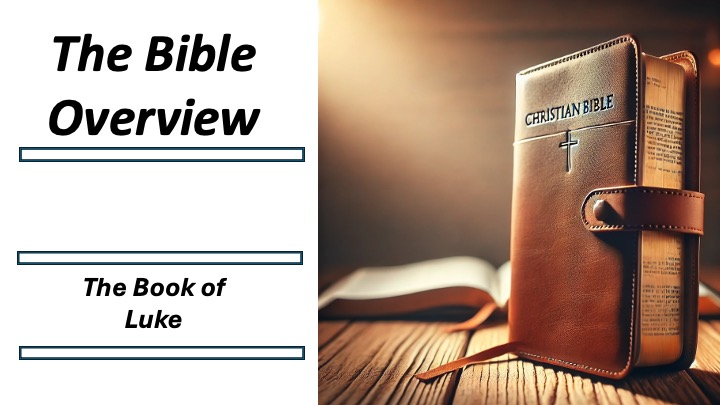Bible Overview Luke
Mike Ervin

Gospel
of Luke: Overview
Authorship
Traditional View:
• Attributed to Luke, a physician and companion of Paul (Colossians 4:14,
Philemon 24).
• Early church fathers (Irenaeus, Clement of Alexandria) affirm Luke as the
author.
• Also credited as the author of Acts, forming a two-volume work.
Modern Scholarly View:
• Most scholars accept Luke as the author but acknowledge some anonymous
authorship theories.
• Strong evidence suggests that Luke-Acts was written by the same person,
likely a well-educated Greek-speaking Christian.
• Some debate over whether Luke personally knew Jesus or relied on oral and
written sources (Luke 1:1-4).
Date of Authorship
• Traditional View: Written before 70 AD, possibly 60–62 AD, before Paul’s
death.
• Modern View: Most scholars date it 80–90 AD, after the destruction of the
Jerusalem Temple (70 AD), given Luke’s reference to events in hindsight.
Intended Audience
• Written to Theophilus (Luke 1:3), likely a wealthy Gentile convert or patron.
• More broadly, aimed at Gentile Christians, explaining Jewish customs and
emphasizing Jesus as the Savior of all people.
Major Themes
1. Jesus as the Universal Savior – Emphasis on salvation for Jews and Gentiles
alike.
2. Compassion for the Marginalized – Highlights women, the poor, sinners, and
outcasts (e.g., Mary, the Good Samaritan, Zacchaeus).
3. Prayer & the Holy Spirit – More references to Jesus praying than in
other Gospels; strong emphasis on the Holy Spirit’s role.
4. Parables & Teachings – Luke contains some of Jesus’ most famous
parables, like the Prodigal Son and Good Samaritan.
5. Joy & Praise – Repeated themes of joy, praise, and songs, especially in
the birth narratives and resurrection accounts.
Chapter-by-Chapter Summary
I. Birth & Early Ministry of Jesus (Ch. 1–4)
• Ch. 1 – Announcements of John the Baptist’s and Jesus’ births; Mary’s
Magnificat.
• Ch. 2 – Jesus’ birth in Bethlehem, presentation at the Temple, and boyhood
visit to Jerusalem.
• Ch. 3 – John the Baptist’s ministry, Jesus’ baptism, and genealogy tracing back
to Adam.
• Ch. 4 – Jesus’ temptation in the wilderness; first teaching at Nazareth’s
synagogue.
II. Jesus’ Teachings & Miracles (Ch. 5–9)
• Ch. 5 – Calling of Peter, James, John, healing the paralytic, and Levi’s
calling.
• Ch. 6 – Sermon on the Plain (similar to the Sermon on the Mount in Matthew).
• Ch. 7 – Healing the centurion’s servant, raising the widow’s son at Nain.
• Ch. 8 – Parable of the Sower, Jesus calms the storm, heals Jairus’ daughter.
• Ch. 9 – Feeding of 5,000, Peter’s confession, the Transfiguration.
III. Journey to Jerusalem & Parables (Ch. 10–19)
• Ch. 10 – Parables of the Good Samaritan and Martha & Mary.
• Ch. 11 – Jesus’ teachings on prayer and conflict with religious leaders.
• Ch. 12–13 – Warnings about hypocrisy, watchfulness, and repentance.
• Ch. 14 – Parable of the Great Banquet.
• Ch. 15 – Parables of the Lost Sheep, Lost Coin, Prodigal Son.
• Ch. 16 – Parable of the Rich Man and Lazarus.
• Ch. 17–18 – More teachings on faith, persistence, and humility.
• Ch. 19 – Triumphal Entry into Jerusalem, Jesus weeps over the city.
IV. Passion, Crucifixion & Resurrection (Ch. 20–24)
• Ch. 20–21 – Jesus’ teaching in the Temple, warnings of future judgment.
• Ch. 22 – Last Supper, Gethsemane, Peter’s denial.
• Ch. 23 – Trial before Pilate, crucifixion, burial.
• Ch. 24 – Resurrection, Road to Emmaus, Ascension.